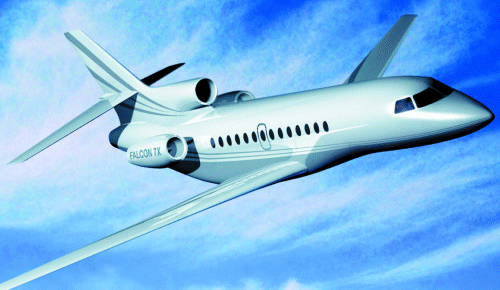GRAHAM WARWICK / WASHINGTON DC
Renamed FNX to compete with the Bombardier Global Express and Gulfstream IV
Dassault has renamed its FNX long-range, high-speed business jet the Falcon 7X and slipped the first flight from late 2004 to early 2005. The company holds 41 deposits on the trijet, to be certified in mid-2006, with first delivery later that year.
With a range of 10,500km (5,675nm) at Mach 0.8, the Falcon 7X is designed to compete with the Bombardier Global Express and Gulfstream IV long-range business jets. Dassault says the fly-by-wire aircraft will cost 12% more than the now top-of-the-range Falcon 900EX, which sells for $33 million equipped, at 2004 prices.
While all Dassault's current business jets share the same supercritical-section wing, originally developed for the Falcon 50, the latest aircraft features a new wing with increased sweep and span. Olivier Villa, vice-president Falcon programmes, says the wing is "an optimised high-transonic design with a double-digit improvement in [lift-to-drag ratio] over present-day Falcon wings". The structure is simplified to reduce weight and cost.

The Falcon 7X has a maximum operating Mach number of 0.9, allowing most flights to be conducted at speeds above M0.85, says Dassault. The 10,500km design range, although shorter than its rivals, allows the aircraft to fly long haul intercontinental routes. "From the US West Coast, it gives you Toyko going west and all of Europe going east," says Dassault Falcon Jet president John Rosanvallon.
Fuselage cross-section is the same as that of the Falcon 900EX, but the cabin is over 2.4m (8ft) longer, increasing volume by 20%. A new pressurisation system will provide a lower cabin altitude of 6,000ft (1,800m). The cockpit will feature the EASy advanced flightdeck under development for the Falcon 900EX and 2000EX, featuring four large liquid-crystal displays and based on Honeywell's Primus Epic integrated avionics.
Confirming selection of the 6,100lb-thrust (21.7kN) Pratt & Whitney Canada PW307A to power the Falcon 7X, Dassault says other risk-sharing partners will include: Honeywell for avionics architecture, 35-150(FN) auxiliary power unit, air management system and, in conjunction with Parker Aerospace, the power generation system; Aircraft Braking Systems for the wheels, brakes and brake control system; and TRW Aeronautical Systems, which will provide the hydromechanical flap and airbrake systems.
The Falcon 7X will be an addition to Dassault's business jet line-up, which comprises the mid-size Falcon 50EX, super mid-size Falcon 2000 and 2000EX and large Falcon 900C and 900EX. The company says it has seen no downturn in sales this year, with 55 orders placed in the first half of the year. United Airline's new fractional-ownership subsidiary Avolar converted a letter of intent for 100 Falcons into a contract for 122 aircraft in late October, of which 76 are options.
Dassault, meanwhile, began flight-testing the P&WC PW308C-powered Falcon 2000EX on 25 October. Certification is set for the third quarter of next year, with deliveries starting in 2003. Delivery of aircraft equipped with the EASy flightdeck will begin in 2004. Compared with the 2000, the $23.5 million 2000EX offers a 25% increase in range (to 7,000km) and a 3min faster time to a 41,000ft initial cruise altitude, as a result of re-engining and a 31% increase in fuel capacity.
Source: Flight International



















